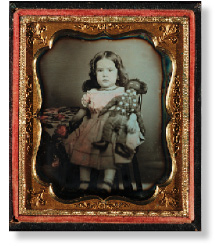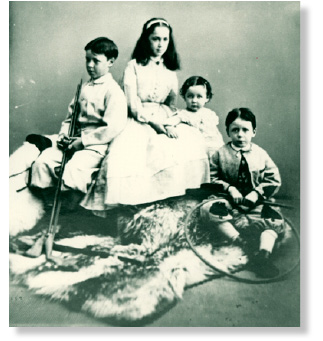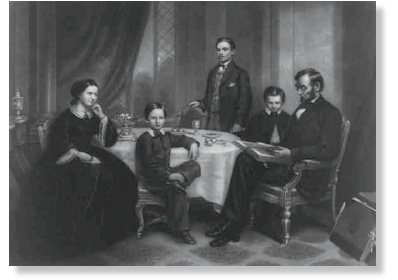Patriotic Children
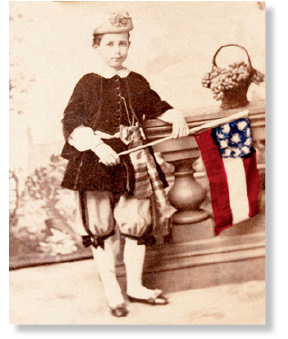
A boy holding a Confederate flag called the “Stars and Bars” shows support for the Southern cause.
When we read about the Civil War, it is often stories about soldiers in battle or women on the home front. But adults were not the only people involved in the war. In every town and city, on every farm and in every school, children exercised their patriotic duty in their own ways. Whether Union or Confederate, children cheered their fathers and brothers in the army with letters from home. Children took care of the family homes and farms while soldiers were away in battle. And all children suffered from loneliness and the uncertainties of war, just as grown-ups did.
Raising Money
Children joined groups such as Soldiers’ Aid Societies in both the North and the South. They organized fairs and raffles to raise money. Often they made and sold patriotic cockades—badges made of buttons and ribbon that celebrated the flag of the North, the South, or a state. Children performed in plays and concerts that had patriotic themes. Such entertainment often featured tableaux vivants, where costumed actors sat motionless and silent on a stage to re-create a famous picture or scene from history. Through these efforts, Northern children donated at least $100,000 to the care of the soldiers.
Care Packages
Young people also helped supply the soldiers with food and clothing. Children raised food that could be packaged and sent to the battlefront and made special treats of preserved fruits and jams for hospitalized soldiers. They made clothing, towels, and bandages that could be delivered to the field. Ten-year-old Emma Andrews from Ohio made 229 towels and handkerchiefs. The Canandaigua (New York) Young Ladies Society made 133 pairs of long underwear, 101 shirts, and many other clothing items in one year. Often, the children enclosed notes in the things they made to encourage and cheer the soldiers: “These stockings were knit by a little girl five years old, and she is going to knit some more, for mother said it will help some poor soldier.”
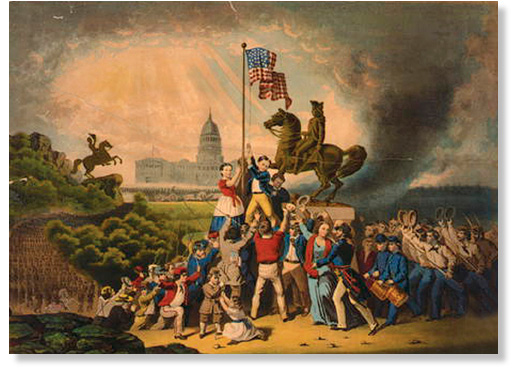
When the war broke out, patriotic spirits were high. This illustration shows children raising the Union flag, with the nation’s Capitol building in the distance.
Making Do
Times were hard for people on both sides during the war. But life was especially difficult for children growing up in the Southern states. Union and Confederate soldiers marched through their towns and farms. The soldiers took food and livestock. They tore down fences and buildings for firewood. Schools and homes were turned into hospitals during and after battles. Everyday items such as paper and pencils were scarce. Like everyone else, children learned to “make do.”
Twice-Turned Clothes
When kids outgrew their clothes, it was difficult to buy cloth to make new ones. Girls helped their mothers weave a plain cloth called homespun. When girls outgrew their dresses, mothers let down the hems. Shirts and pants were “twice-turned.” That is, when they were worn out, they were turned inside out and then restitched to hide the worn spots. Old homespun clothes were unraveled and woven into new garments. Children dyed wool with colors made from onion skins, berries, and nuts. Boys and girls braided straw into hats and went barefoot to save shoe leather.
Young Hands at Work
With fathers serving in the army, children helped their mothers run their farms. Boys herded hogs, milked cows, and plowed fields. They planted wheat, and they boiled molasses. Girls made candles and soap with animal fat. They washed clothes in kettles of boiling water. Even the littlest children swept floors and dried dishes.
In 1863, young Anne Frobel of Virginia wrote in her diary: “…not an ear of corn, or grain of any kind on the place….” Boys planted crops, hunted, and fished. Girls picked berries and crab apples. Children planted and picked goober peas (we call them peanuts). Children learned to find food, too. Eight-year-old Sally Hawthorne of North Carolina gathered corn kernels left by the chickens. “We are so hungry,” she wrote, “and it is so good.”
Cornhusk Dolls and Whirligigs
As the war dragged on, everyone became tired of poor food and hard work. Children still found time to play, though. Outdoors, they played games such as fox-and-geese and blindman’s bluff. Boys carved animals and whittled moving toys like whirligigs. Girls made dolls from rags and cornhusks.
Children’s magazines were filled with stories about heroism, bravery, selflessness, and patriotic duty. Everyone knew a soldier on a distant battlefield. And just like their fathers and older brothers, children answered their country’s call. These patriotic children on the homefront did all they could for the soldiers of their army, North or South.
